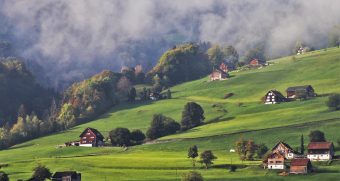
If I imagine a country like the one in a fairy tale, with beautiful forests, lakes and cows that graze contentedly and give healthy, whole milk, from which the most delicious cheeses and the sweetest chocolates are made, it is undoubtedly Switzerland. Aware of the preciousness of their natural beauties, but also of the increasingly dangerous climate change, the Swiss have not left environmental issues to chance for a long time. According to the ambassador of this country to Serbia, Urs Schmid, it is very important for Swiss citizens to breathe as clean air as possible and know where and how the food they eat is produced. That is why they support all measures implemented by the government to achieve zero emissions of greenhouse gases. That is why, among other things, people drive more often electric and hybrid vehicles, and they are still, standardly, peddlers in the production and consumption of healthy organic food.
EP: From 2020, electricity from unverifiable sources, called grey energy, will no longer be permitted. What are the next steps for Switzerland when it comes to energy, especially in terms of the right energy mix?
Urs Schmid: The Swiss Federal Office of Energy (SFOE) published the Energy Perspectives 2050+ in November 2020. There are more scenarios on how to achieve this, but they all have in common that domestic renewable energy production will be greatly expanded by 2050. Energy efficiency will be improved, while fossil fuels will largely disappear and be replaced by electricity and electricity-based energy carriers such as hydrogen. All in all, the energy system in 2050 will be secure, clean, and less dependent on foreign energy than it is today. With the envisaged full market opening, small electricity consumers will receive a default product consisting of 100 percent Swiss renewable electricity, also called “green default”. Small consumers may also switch to the open market or choose another renewable product.
EP: How will Switzerland achieve the government’s net-zero greenhouse gas emissions target in the near future?
Urs Schmid: With the revised CO2 Act, Switzerland’s greenhouse gas emissions are to be halved by 2030 compared to 1990 levels. Until then, emission reduction targets are: for the buildings -65 percent, for the transport -25 percent, for the industry -35 percent and -20 percent for agriculture. As before, the Federal Council is reviewing further measures should the annual greenhouse gas inventory published by the FOEN show that a sector is not on target. The main measures are the CO2 tax combined with the climate fund and the emission trading system, which is linked to the one of the EU.
EP: The 47-year-old Mühleberg nuclear power plant near Bern was permanently switched off in December 2019. This is the first of five Swiss nuclear power reactors to be decommissioned. What is “the expiry date” for the remaining nuclear plants?
Urs Schmid: There are now four nuclear power plants (NPPs) left in Switzerland: Beznau I and II, Gösgen and Leibstadt. They have an unlimited operating license and may be operated as long as they are safe. The operators must ensure safety at all times and always upgrade their plants to the latest state of the art. In doing so, they are monitored by the Swiss Federal Nuclear Safety Inspectorate (ENSI). Even with an unlimited license, there are limits to how long an NPP can operate. The reason for this is the ageing of the large components but also economic considerations, which is why the Mühleberg was closed. Following the Fukushima nuclear accident, the Federal Council decided in 2011 to gradually phase out nuclear energy. Parliament followed the decision and Swiss voters also approved this decision in a referendum vote in 2017. With this, the construction of new nuclear power plants was prohibited. Existing nuclear power plants may remain in operation as long as they are safe. Therefore, there is no exact “expiry date” for the Swiss NPPs.

EP: By signing the Paris Agreement in 2016, the government said it had signaled its long-term aim of reducing Switzerland’s carbon emissions by 70-85 percent by 2050. What has been done since signing the Agreement?
Urs Schmid: In addition to all of the above, the Federal Council decided to reduce Switzerland’s carbon emissions and thus join the large number of countries aiming to achieve net-zero targets by 2050, bringing its commitments in line with the recommendations of the Intergovernmental Panel on Climate Change (IPCC) to remain below 1.5°C. In brief, Switzerland decided to increase its greenhouse gas emission reduction goal by 2030 while increasing the amount of the domestic share of emission reduction and to compensate imported “grey” emissions through additional emissions reductions abroad
EP: Because of air pollution, some one-fifth of the country’s forests were classified as severely damaged in the late 20th century. Reforestation efforts helped restore some of these areas. What is the situation with trees these days, and how does your homeland manage air pollution? Urs Schmid: The critical damages in the Swiss forests – similar to the European Forest – were noted in 1983-1986, with systematically estimating and monitoring the defoliation. As a result, from 1990, Switzerland introduced very strict standards and regulations on emissions from traffic but also from house heating and from industrial production. This drastically reduced air pollution of, e.g. nitrogen oxide, sulfur dioxide, hydrocarbons and other damaging gases and helped the forests to recover without additional reforestation. The recovery of forests worked until 2018 when an arid summer caused again heavy damages of mainly spruce and beech (which are the two main forest species in Switzerland) – 3 times heavier than in the 1980ies. Another alarming factor is the increase of nitrogen in the soil, coming mainly from agriculture. So an adaptation of forests to climate change will be the key challenge for the next decades.
Interviewed by: Jovana Canić
Read the story in the new issue of the Energy portal Magazine RECYCLING.



